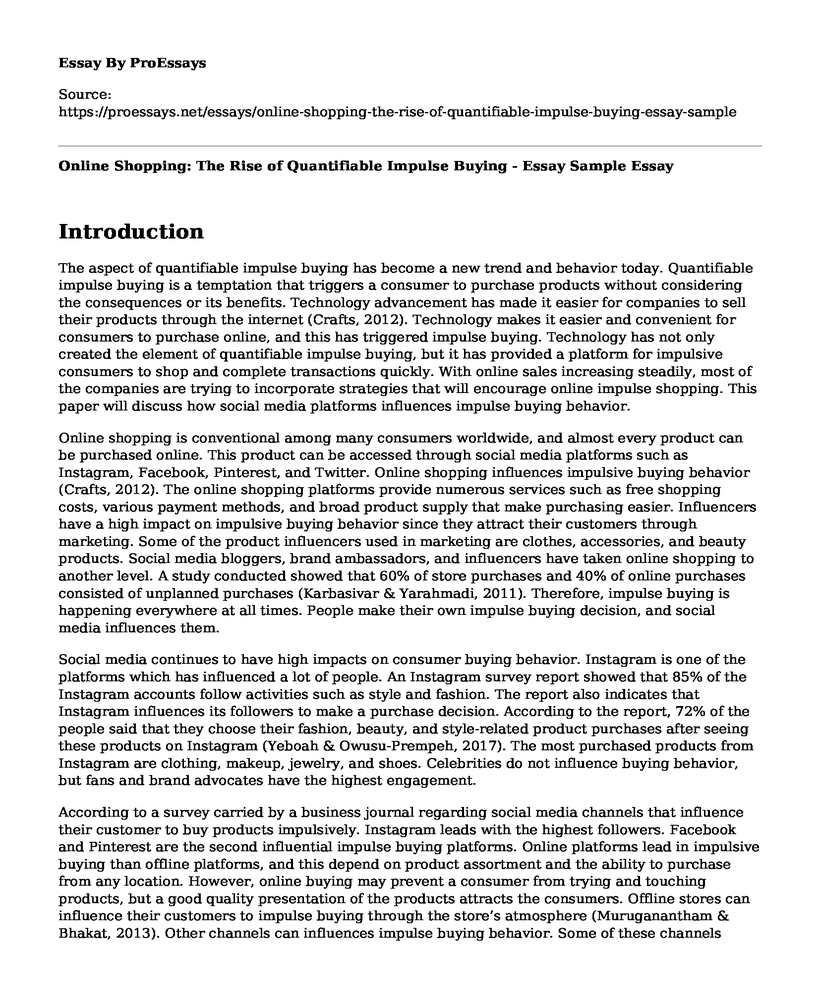Introduction
The aspect of quantifiable impulse buying has become a new trend and behavior today. Quantifiable impulse buying is a temptation that triggers a consumer to purchase products without considering the consequences or its benefits. Technology advancement has made it easier for companies to sell their products through the internet (Crafts, 2012). Technology makes it easier and convenient for consumers to purchase online, and this has triggered impulse buying. Technology has not only created the element of quantifiable impulse buying, but it has provided a platform for impulsive consumers to shop and complete transactions quickly. With online sales increasing steadily, most of the companies are trying to incorporate strategies that will encourage online impulse shopping. This paper will discuss how social media platforms influences impulse buying behavior.
Online shopping is conventional among many consumers worldwide, and almost every product can be purchased online. This product can be accessed through social media platforms such as Instagram, Facebook, Pinterest, and Twitter. Online shopping influences impulsive buying behavior (Crafts, 2012). The online shopping platforms provide numerous services such as free shopping costs, various payment methods, and broad product supply that make purchasing easier. Influencers have a high impact on impulsive buying behavior since they attract their customers through marketing. Some of the product influencers used in marketing are clothes, accessories, and beauty products. Social media bloggers, brand ambassadors, and influencers have taken online shopping to another level. A study conducted showed that 60% of store purchases and 40% of online purchases consisted of unplanned purchases (Karbasivar & Yarahmadi, 2011). Therefore, impulse buying is happening everywhere at all times. People make their own impulse buying decision, and social media influences them.
Social media continues to have high impacts on consumer buying behavior. Instagram is one of the platforms which has influenced a lot of people. An Instagram survey report showed that 85% of the Instagram accounts follow activities such as style and fashion. The report also indicates that Instagram influences its followers to make a purchase decision. According to the report, 72% of the people said that they choose their fashion, beauty, and style-related product purchases after seeing these products on Instagram (Yeboah & Owusu-Prempeh, 2017). The most purchased products from Instagram are clothing, makeup, jewelry, and shoes. Celebrities do not influence buying behavior, but fans and brand advocates have the highest engagement.
According to a survey carried by a business journal regarding social media channels that influence their customer to buy products impulsively. Instagram leads with the highest followers. Facebook and Pinterest are the second influential impulse buying platforms. Online platforms lead in impulsive buying than offline platforms, and this depend on product assortment and the ability to purchase from any location. However, online buying may prevent a consumer from trying and touching products, but a good quality presentation of the products attracts the consumers. Offline stores can influence their customers to impulse buying through the store’s atmosphere (Muruganantham & Bhakat, 2013). Other channels can influences impulse buying behavior. Some of these channels influence personal and situational characteristics. These channels are variables, and they include gender and age. The most affected gender in impulsive buying is girls. Girls like products that are trending, which they are forced to purchase unwillingly. For example, fashionable clothes and beauty products. People are attracted to impulse buying through sales promotion, product appeal. Reward promotion attracts a large number of impulse buyers than unrewarding products. These products are advertised on social media platforms, therefore, making it easier for people to acquire them.
References
Crafts, C. E. (2012). Impulse buying on the internet. https://digitalcommons.lsu.edu/gradschool_theses/4169/
Karbasivar, A., & Yarahmadi, H. (2011). Evaluating effective factors on consumer impulse buying behavior. Asian Journal of Business Management Studies, 2(4), 174-181. http://www.academia.edu/download/32192294/4.pdf
Muruganantham, G., & Bhakat, R. S. (2013). A review of impulse buying behavior. International Journal of Marketing Studies, 5(3), 149. https://www.academia.edu/download/53829520/24570-89697-1-PB.pdf
Yeboah, A., & Owusu-Prempeh, V. (2017). Exploring the Consumer Impulse Buying Behaviour from a Range of Consumer and Product Related Factors. International Journal of Marketing Studies, 9(2), 146-159. https://pdfs.semanticscholar.org/855e/e8eba168c7fdb249b4e54c13338ec80f087f.pdf
Cite this page
Online Shopping: The Rise of Quantifiable Impulse Buying - Essay Sample. (2023, Aug 28). Retrieved from https://proessays.net/essays/online-shopping-the-rise-of-quantifiable-impulse-buying-essay-sample
If you are the original author of this essay and no longer wish to have it published on the ProEssays website, please click below to request its removal:
- Research Proposal Example on Online Shopping and Consumers' Privacy Concerns
- Organizational Leadership Structure Essay
- Essay Sample on Small Cab Marketing Strategy
- Essay Sample on Strategy Formulation
- Essay Sample on Brand Exploratory
- Essay Sample on Internal Business, Financial, Customers and Innovative Learning
- Developing a Winning Competitive Strategy: Analyzing Target Market - Essay Sample







